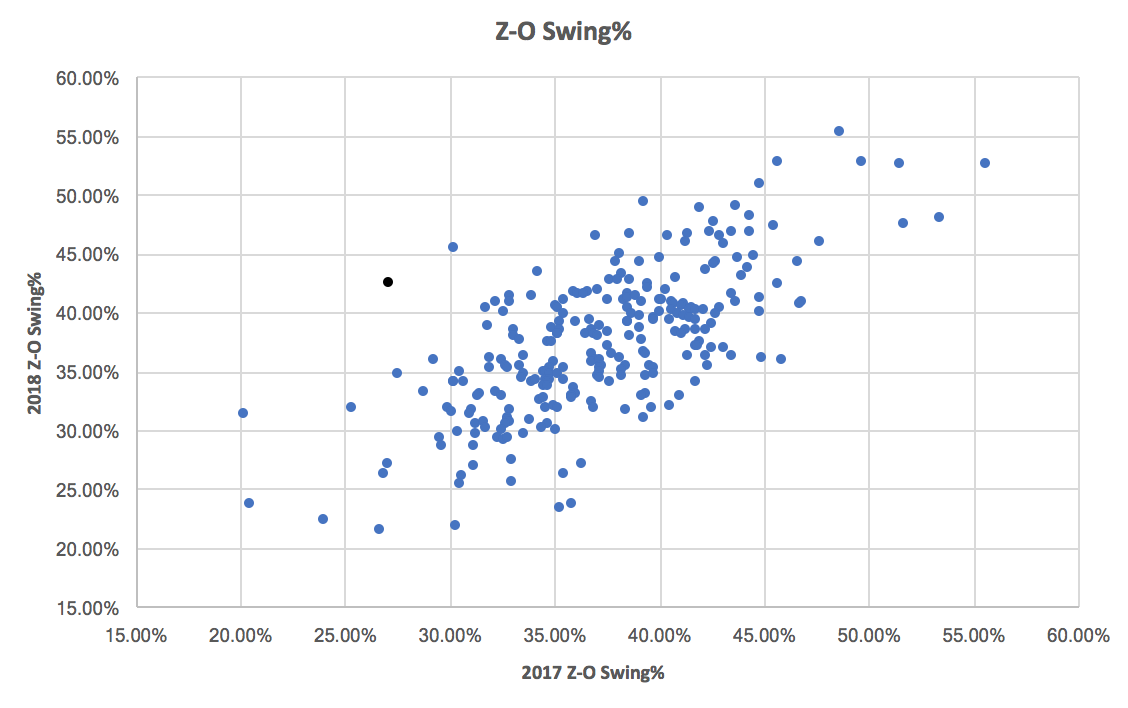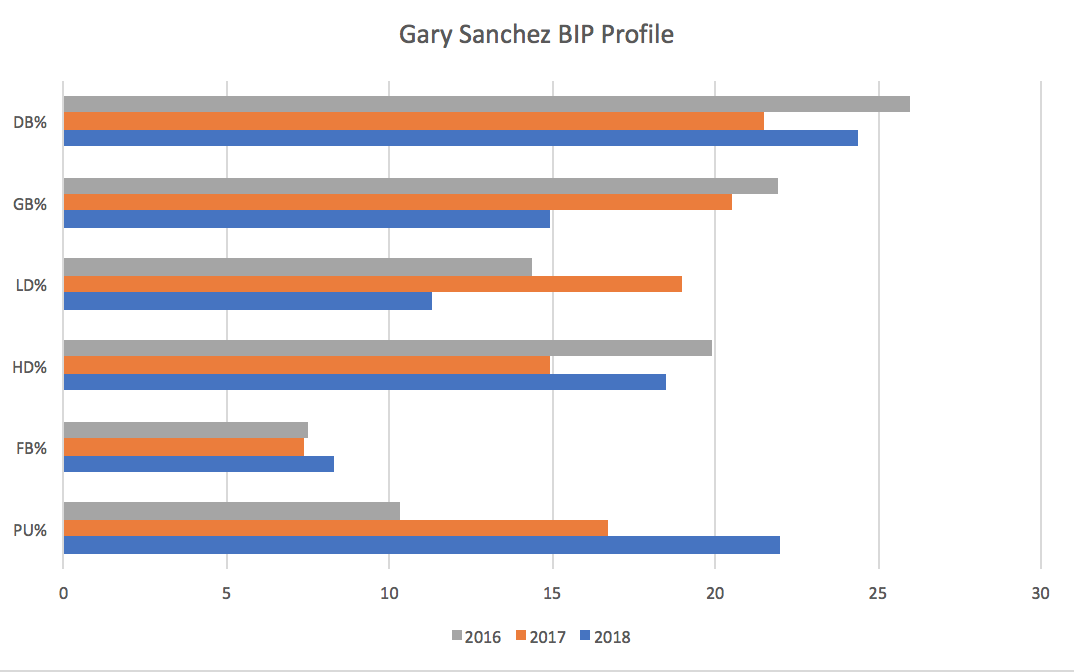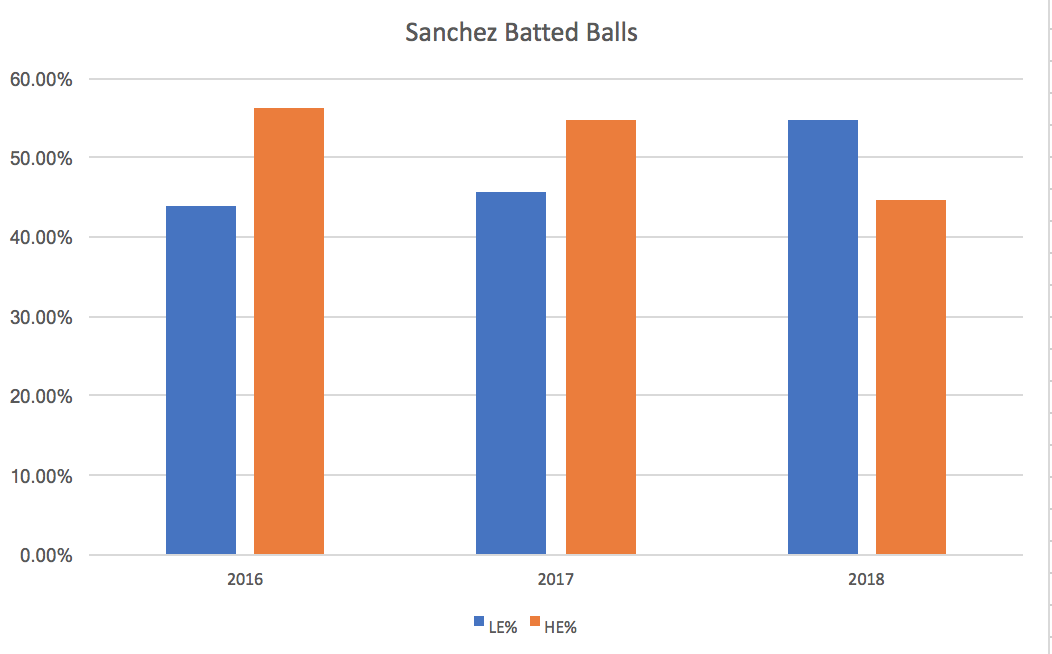(Photo by Rich Graessle/Icon Sportswire)
Even after a tiny skid of late, the New York Yankees still lead the league in winning percentage. Their playoff chances certainly haven’t taken a hit. It’s a long season, and baseball doesn’t always fall your way. The Yankees did, however, learn some bad news on top of the skid—yesterday, catcher Gary Sanchez was placed on the disabled list, and is expected to miss 3-4 weeks.
Let’s go back to before the season began, when you probably had grand expectations for Sanchez. Erase what you know about this season. What would your reaction be to hearing Sanchez was placed on the DL?
“The Yankees lost one of their big three and a star player.”
Probably something like that, at least. Your expectation would be that the Yankees offense would take a hit, for the short time they are without Sanchez. Well, they currently sport the second-best offense in baseball, by wRC+. And I think you would have a hard time arguing that Sanchez has contributed to that standing. He’s still been a rock behind the plate and graded as one of the best defensive catchers in the game. Offensively, though, he’s been incredibly disappointing. Will the Yankees really miss him?
In short, probably. Despite those offensive shortcomings thus far, he’s proven his value as a hitter and that track record lends itself to the belief that he will figure it out eventually. Great hitters usually do. But there is one guy who will likely decide how much the Yankees will miss Sanchez. And if he keeps doing what he’s done in limited time this season, they probably won’t miss him at all. That guy is Austin Romine.
Romine is currently sporting a 133 wRC+ with a 9.4% walk rate and 18.8% strikeout rate. The sample is tiny, though, as it has come in only 92 plate appearances. Is there anything believable in this?
I like to use swing rate at pitches inside the strike zone minus swing rate at pitches outside of the strike zone (Z – O Swing%) as a basic measurement of plate discipline. I’ll point you to this plot of Z – O Swing% for hitters in 2017 (min 250 plate appearances) vs Z – O Swing % for hitters in 2018 (min 90 plate appearances) Romine is in black:

You see Romine out on his own because no hitter in this group has improved their Z – O Swing% from 2017 to 2018 as much as Romine has. Will it stick? Romine will have to prove he can keep hitting the ball well to stay true to this discipline, but it’s certainly a good start. As Romine begins to start most games for the Yankees, pitchers will adjust to find weaknesses and try to pitch him out of his approach.
It is worth noting that his exit velocity has spiked nearly five mph from last season and his launch angle is up 4.5 degrees. He had three barrels in 159 batted balls last season and already has four in 61 this season. However, his batted ball data is such a small sample that it is hard to draw much of anything from it. Romine had a 49 wRC+ last season, and a 68 the year before that. It’s hard to believe he will produce anything close to what he has so far in 2018. But with much improved peripheral numbers it’s quite possible he could at least match Sanchez’s overall offensive contributions.
Now, let’s see what has gone wrong for Sanchez this year. When looking at Sanchez’s offensive profile for 2018, you see plate discipline metrics trending in the right direction. Fewer chases outside of the strike zone, an improved whiff rate, a walk rate up more than 4% from last season. His hard hit rate is nearly identical to last season—14 home runs is no disappointment. So, how does this add up to a wRC+ of 97? Because Sanchez is batting just .190 on the season. If a presumed star is sporting a batting average that low, our first instinct is to go to BABIP. Ah, Sanchez has a .197 BABIP. There’s the issue! Yes, that is the issue, but not an issue of poor luck. Sanchez has a .222 xBABIP, the BABIP is bad on the surface and underneath the hood. That is our issue.
We are talking batting average on balls in play (BIP), so let’s look at his BIP profile across his three seasons:

We go down the line, and nothing looks too out of whack and…wait, what is going with that last one down there? That’s pop up rate, which Sanchez has done on 22% of his batted balls this season. That’s a 5.3% increase from 2017, after a 6.4% increase between 2016 and 2017. The single worst thing you can do when putting the ball in play is send it straight up into the air. Pop ups have a .020 BABIP. Sanchez is doing that an awfully high clip.
The pop ups are the most glaring issue in his BIP profile, but there are problems as a whole. Dribblers (DB%, .124 BABIP) and fly balls (FB%, .202 BABIP) follow pop ups as the worst possible chance for a hit inside the stadium. Remember, home runs are excluded from BABIP. Next is our ground balls (GB%, .368 BABIP) and high drives (HD%, .472 BABIP). Lastly, we have our low drives (LD%, .760), which have by far the greatest hit expectancy. High drives are better overall than low drives because they produce far better power numbers, but BABIP simply looks at dropping for a hit or not, dictating the greater BABIP on low drives.
Let’s group the three former BIP categories and call them our low expectancy balls in play, and then group the three former categories as our high expectance balls in play. Here is rate of low expectance balls hit (LE%) and rate of high expectance balls hit (HE%) across his three seasons:

Sanchez’ rate of batted balls with a high expectance for a hit has decreased 10% from 2017 to 2018. In both 2016 and last season, his batted ball profile had significantly more balls in play with a high BABIP. It’s not just pop ups that could be a culprit for the low BABIP. If you refer to the first chart again, you can see that Sanchez’s ground ball rate and low drive rate have diminished. We don’t want more ground balls from a hitter, but we certainly don’t want them to be replaced by pop ups and dribblers.
However, there are a couple positives that can be returned from his batted ball distribution. First, his high drive rate is nearly right where it was in his absurd short 2016. The 18.5% high drive rate ranks 15th in the majors among the 185 hitters with at least 150 batted balls. These represent the true ability for a hitter to crush the ball. Secondly, low drive rate is the noisiest batted ball category. Sanchez’s low drive rate should regress to the mean as it is significantly below league average.
The consistency of his increasing pop up rate and plummeting ground ball rate causes concern that his BABIP may not rise too much. An improved low drive rate should help with that awful average, and Sanchez certainly hasn’t lost the ability to crush the ball.
The Yankees want Sanchez out there. If nothing else, to give him more time to get out of this slump. If they actually lose anything in offensive production remains to be seen, though. With Austin Romine showing life, the Yankees offense might not miss a beat. Will they miss their young catcher, though? Of course.

gary sanchez has no value to the yankees if he can not hit. He is probably the worst defense catcher in baseball.He is plain lazy behind the plate. He is slow to react on balls in the dirt.He has two assets,great arm,and can hit.He is not the catcher of the future for the yankees.do you want him catching in the 7th game of the world series,score tied,and the winning run on third base.
He’s far from the worst defensive catcher in baseball. Pitch framing metrics show he’s one of the better pitch framers in the game. I’ll admit, a big pet peeve of mine is his lack of flexibility and thus, inability to move laterally behind the plate. When pitches are far from him, he tries to backhand the pitches instead of getting his body in front of them. Therefore, he has allowed the most passed balls (9) in baseball- he allows one every 50ish innings. But Omar Narvaez has allowed 8 in 160 fewer innings (1 every 36ish innings). I get why people criticize his defense, but he’s FAR from the worst in the game.
You’re spot on – Sanchez also doesn’t call a good game. On the scale of 1-10 with 10 great defense, Romine is a 9 and Sanchez is a 6. Great arm – but lazy blocking wild pitches or even good pitches. If he can’t hit he is of minimum vale.
defense also pertains to his arm.worst in the league no way – his arm makes up for his mit.he will be back & maybe he gets hot.we can afford to let him ride with how good the other guys have been.
Did you not read the article dumb ass “time they are without Sanchez. Well, they currently sport the second-best offense in baseball, by wRC+. And I think you would have a hard time arguing that Sanchez has contributed to that standing. He’s still been a rock behind the plate and graded as one of the best defensive catchers in the game.
Statcast has him top 10 in pop time to 2B (8th, 1.95 seconds) and throwing velocity (6th, 86.7MPH). You can knock him, however, for his exchange time (ball going from glove to hand). Its one of the slowest in baseball and probably why he’s not higher rated on defensive metrics.
I have been watching baseball for 55 years and I have never seen a worse defensive catcher. He simply cannot catch. He has a strong arm but that is it. I have seen more strike-em-out, runner reaches first due to Sanchez’s inability to catch than I have seen in my lifetime. Unless he hits he is only a liability to the Yanks. Romine is a much more balanced choice.